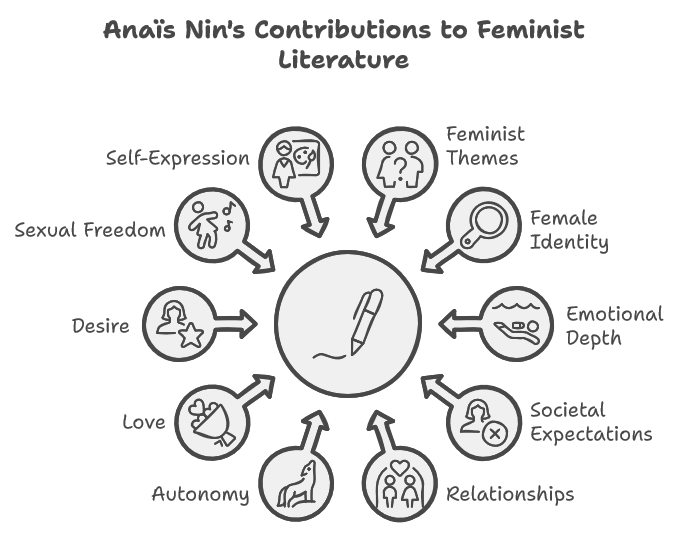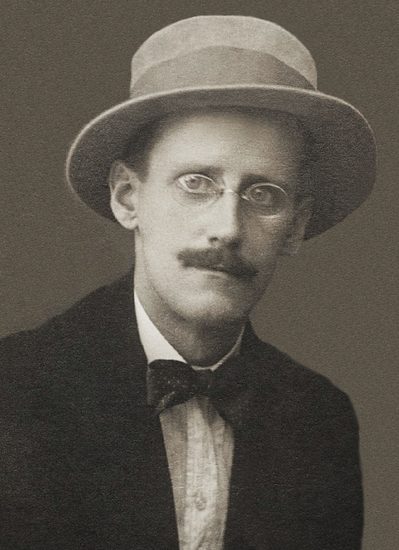Anaïs Nin (1903–1977) was a French-Cuban-American writer whose innovative literary contributions have left a profound impact on 20th-century literature. Born in France to a French father and a Cuban mother, Nin’s multicultural background played a significant role in shaping her identity and writing style. She moved to the United States as a child and became part of the vibrant literary scene in Paris during the 1930s, where she mingled with influential writers and artists. Nin is best known for her diaries, which offer intimate glimpses into her thoughts and experiences, as well as her groundbreaking erotic literature that explores the complexities of desire and identity. Additionally, her writings often reflect feminist perspectives, emphasizing the inner lives of women and their struggles for self-expression and autonomy in a patriarchal society.
Nin’s work is celebrated for its exploration of human relationships, sexuality, and the emotional landscape of women. Through her diaries and erotic fiction, she challenged conventional narratives and opened up discussions about female desire and agency. This unique blend of introspection and boldness has solidified her place as a significant figure in both feminist literature and the broader literary canon.
1. The Significance of Her Diaries
Anaïs Nin began her journey as a diarist at the tender age of 11, a practice that would continue throughout her life and yield over 35,000 pages of writing. Her diaries not only document her daily experiences but also serve as a rich tapestry of her innermost thoughts, fears, and aspirations. As she matured, the content of her diaries evolved, reflecting her growing understanding of herself as a woman and an artist.
The literary merit of Nin’s diaries lies in their candid and introspective nature. Unlike traditional autobiographies, her diaries delve deep into the complexities of her relationships, revealing her struggles, triumphs, and the often tumultuous emotional landscape she navigated. The raw honesty of her writing provides readers with an intimate connection to her life, making her experiences relatable and profound.
Several key volumes of her diaries have been published, including The Diary of Anaïs Nin, Volume One (1931–1934) and Volume Four (1944–1947). These works offer invaluable insights into her personal life, detailing her relationships with literary figures, her explorations of sexuality, and her evolving views on love and art. Through these writings, Nin not only documents her own journey but also invites readers to reflect on their own experiences of love, identity, and self-discovery.
2. Groundbreaking Erotic Literature
Anaïs Nin is particularly renowned for her erotic short stories, which broke new ground in the portrayal of female sexuality. At a time when sexual expression was often relegated to the shadows, Nin’s work boldly confronted societal norms, providing a fresh perspective on desire and intimacy. Her writings not only challenged conventional portrayals of women in literature but also opened up conversations about the complexities of female sexuality.
Two of her most notable collections, Delta of Venus and Little Birds, showcase her exceptional talent for blending eroticism with literary artistry. Delta of Venus, written in the early 1940s for a private collector, consists of short stories that celebrate the intricacies of erotic desire, often highlighting the psychological and emotional dimensions of sexual encounters. In contrast, Little Birds, published posthumously, presents a collection of stories that explore various facets of sexuality, emphasizing the sensual and often transformative nature of intimate relationships. Both collections reveal Nin’s ability to intertwine vivid imagery and lyrical prose, making her stories not only sensual but also deeply reflective.
Nin’s lyrical writing style elevates her erotic literature, transforming it into an exploration of the human experience. Her prose is rich and poetic, evoking a sense of beauty and intimacy that draws readers in. Central to her narratives are themes of female desire and sexual autonomy; she presents women as complex individuals with their own desires and fantasies, challenging the notion that female sexuality should be confined to traditional roles. Through her work, Nin reclaims the narrative around female sexuality, affirming that women have the right to express their desires freely and without shame.

3. A Feminist Voice in Literature
Anaïs Nin’s writings are imbued with feminist themes that reflect her commitment to exploring female identity and experiences. At a time when women were often marginalized in literature, Nin gave voice to the complexities of the female psyche, emphasizing the importance of self-discovery and emotional depth. Her work highlights the struggles women face in navigating societal expectations, relationships, and their own identities.
In her diaries and fiction, Nin delves into the intricacies of womanhood, exploring topics such as love, desire, and the quest for autonomy. She paints a vivid picture of the emotional landscapes that women inhabit, revealing their inner conflicts and desires. Through her candid exploration of female experiences, she affirms the significance of women’s voices in literature, making her a crucial figure in the feminist literary movement.
Moreover, Nin’s writings serve as a powerful response to societal constraints on women. She challenges the traditional roles imposed upon women and advocates for their sexual freedom and self-expression. By openly discussing female desire and the complexities of intimacy, Nin dismantles the stigma surrounding women’s sexuality, promoting the idea that women have the right to explore and celebrate their own desires. In doing so, she not only empowers herself but also inspires generations of women to embrace their identities and express their sexuality without fear or shame.
4. Influential Relationships with Other Writers
Anaïs Nin’s literary journey was significantly shaped by her relationships with prominent literary figures, most notably Henry Miller. Their deep intellectual and emotional bond blossomed in the 1930s, when they shared a passionate correspondence and collaborative spirit. Miller’s raw, uninhibited writing style resonated with Nin, encouraging her to explore her own voice more freely. Their exchanges often revolved around the themes of desire, identity, and the creative process, allowing both writers to push the boundaries of their art. In many ways, Miller’s influence can be seen in Nin’s own exploration of eroticism and the complexities of human relationships.
Beyond her connection with Miller, Nin interacted with various influential authors and artists, including writers like Djuna Barnes and poets such as Paul Éluard. These relationships enriched her understanding of literary craft and the artistic community, allowing her to navigate and contribute to the vibrant literary landscape of her time. Through these connections, Nin became recognized as a precursor to modern confessional literature, a genre characterized by personal introspection and emotional honesty. Her diaries and writings reflect this confessional style, marking her as a trailblazer for subsequent generations of writers who sought to explore their inner lives candidly.

5. Literary Collaborations and Community
Anaïs Nin was an integral part of the Parisian avant-garde literary scene in the 1930s, where she cultivated relationships with many influential figures of the time. Her involvement in this vibrant artistic community allowed her to engage with revolutionary ideas and unconventional artistic expressions. Among her notable associations were iconic writers and thinkers, including James Joyce, whose experimental narrative techniques and stylistic innovations inspired her own literary development.
Additionally, Nin maintained friendships with other luminaries such as Gertrude Stein and Isadora Duncan, each of whom contributed to her understanding of art, sexuality, and feminism. These connections not only enhanced her literary repertoire but also solidified her position as a key player in the cultural discourse of her era.
Nin’s literary salons played a crucial role in fostering creative exchange within this community. These gatherings provided a space for writers, artists, and intellectuals to share ideas, critique each other’s work, and discuss the pressing issues of their time. Her salons became a hub for avant-garde thought, encouraging collaboration and experimentation among participants. Through her hospitality and insight, Nin helped cultivate an environment that celebrated artistic freedom and innovation, leaving an indelible mark on the literary and artistic landscape of the 20th century.
Conclusion
Anaïs Nin’s legacy as a pioneering writer is marked by her profound exploration of human emotions, sexuality, and female identity. Her groundbreaking diaries and erotic literature not only challenged societal norms but also provided a voice for women navigating the complexities of their desires and experiences. Nin’s unique ability to blend introspective narratives with poetic language established her as a significant figure in both feminist literature and the broader literary canon. Her work paved the way for future generations of writers who seek to express their inner lives candidly, solidifying her status as a precursor to modern confessional literature.
Nin’s themes of self-discovery, sexual autonomy, and emotional authenticity continue to resonate with contemporary readers, reflecting the ongoing quest for understanding and empowerment in the face of societal constraints. Her writings encourage a deeper examination of personal identity and relationships, inviting readers to embrace their desires and narratives without fear of judgment. As discussions surrounding gender, sexuality, and personal expression evolve, Nin’s work remains a relevant and inspiring touchstone for those seeking to explore the intricacies of the human experience.
Resources
- The Diary of Anaïs Nin – Various volumes, providing detailed insights into her thoughts and experiences.
- “Anaïs Nin: A Biography” by Deirdre Bair – A comprehensive biography that explores Nin’s life, relationships, and literary contributions.
- “Delta of Venus” and “Little Birds” – Collections of her erotic stories that highlight her lyrical writing style and thematic focus on desire and intimacy.
- “Anaïs Nin: A Woman of Many Talents” – An article from the American Writers Museum website: American Writers Museum
- Literary criticism articles on Anaïs Nin – Various academic journals that analyze her influence and themes in her work.
FAQs
1. Who was Anaïs Nin?
Anaïs Nin (1903–1977) was a French-Cuban-American writer best known for her diaries, erotic literature, and feminist perspectives. She explored themes of human relationships, identity, and sexuality, making significant contributions to 20th-century literature.
2. What are Anaïs Nin’s most famous works?
Some of Anaïs Nin’s most famous works include her diaries, particularly The Diary of Anaïs Nin series, and her erotic short story collections, Delta of Venus and Little Birds. These works showcase her lyrical writing style and exploration of female desire.
3. Why are Anaïs Nin’s diaries important?
Nin’s diaries are important for their candid and introspective nature. They provide insight into her personal life, thoughts on love and art, and her struggles as a woman in a male-dominated literary world. They are considered a significant literary achievement, documenting her emotional journey and evolution as a writer.
4. How did Anaïs Nin contribute to feminist literature?
Nin’s work reflects feminist themes by emphasizing female identity and experiences. She explored women’s inner lives and challenged societal constraints on their sexuality, advocating for women’s freedom to express their desires and creativity.
5. What influence did Anaïs Nin have on other writers?
Anaïs Nin had significant relationships with contemporary literary figures, including Henry Miller, which influenced her writing style and thematic focus. Her work has inspired many authors, especially those in the confessional literature genre, and continues to resonate with feminist writers today.
6. What is the significance of Nin’s erotic literature?
Nin’s erotic literature is significant for its groundbreaking portrayal of female sexuality. Her stories celebrate desire and intimacy while challenging societal norms, showcasing women as complex individuals with their own sexual autonomy.
7. What role did Anaïs Nin play in the Parisian literary scene?
Anaïs Nin was an integral part of the Parisian avant-garde literary scene in the 1930s, where she mingled with influential writers and artists. Her literary salons fostered creative exchange and collaboration among artists, contributing to the cultural discourse of her time.
8. How do Anaïs Nin’s themes resonate with contemporary readers?
Nin’s themes of self-discovery, sexual autonomy, and emotional authenticity continue to resonate with contemporary readers, encouraging exploration of personal identity and relationships. Her work invites readers to embrace their desires and narratives in an ever-evolving conversation about gender and sexuality.
